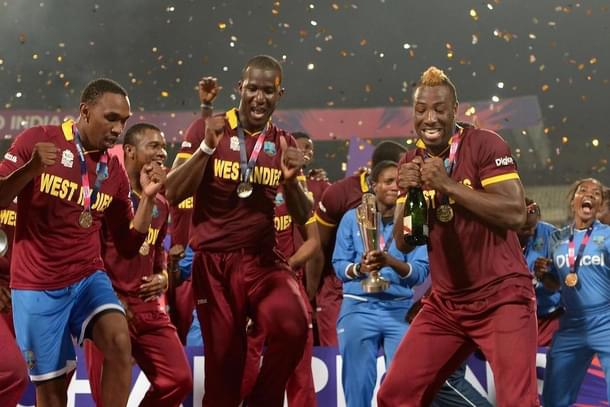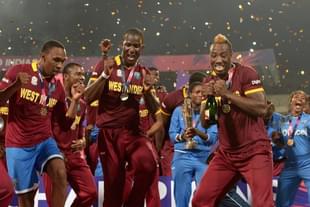Sports
Why International T20 Cricket Needs To Be A Part Of The Olympic Games
Tushar Gupta
Jul 28, 2021, 01:01 PM | Updated 01:00 PM IST
Save & read from anywhere!
Bookmark stories for easy access on any device or the Swarajya app.


Sporting contingents from more than 200 countries are participating in the Tokyo Summer Olympics of 2021.
Cursed by the pandemic, the games this year would invite almost no audience as has been the norm with various other sporting events across the world. Yet, an event that should draw the attention of the world is witnessing a sharp decline in viewership.
As per Comcast’s National Broadcasting Company (NBC) in the United States, the opening ceremony for this year’s games averaged 17 million viewers for both live and delayed broadcasts. The previous low within the US was 20.1 million viewers registered for the 1988 Seoul games while the average viewership for the previous six ceremonies was in the neighbourhood of 25 million viewers.
In 2012, the London Olympics opening ceremony had 40 million viewers tuning in from the US itself.
Even in their grandeur, the Olympics, barring the invested fans, stakeholders, observers, journalists, and sportspersons, do not invite a steady stream of audience that cricket in India does and football in Europe or soccer in the US do. For the average follower, as witnessed earlier this week in India, the glory of the medal supersedes the idea of investing time and energy in the games or sportspersons.
At the end, what people remember, for a few weeks, is the medal tally, or how well or how poorly their country did. As Indians, we are testament to this crude reality for years now.
Meanwhile, as the Olympics have begun losing traction, in the cricketing world, it is the T20 phenomenon that has transformed the game’s ecosystem.
The introduction of T20 cricket has helped the game cater to the millennial generation and deterred the falling popularity in countries like England and West Indies. For countries like Bangladesh, Afghanistan, Sri Lanka, England, Pakistan, and South Africa, T20 cricket offered a shot at success even when the teams were struggling with the traditional red and white ball formats.
West Indies, while registering one dismal performance after the other in Tests and ODIs, could go on to win the T20 World Cup twice in four years (2012 and 2016). Sri Lanka, unable to cope up with the team transition, managed to upset India in 2014.
India, following the shocking exit from the 2007 ODI World Cup in West Indies, registered a comeback and a new beginning in South Africa as they were crowned the maiden T20 champions.
But soon, international T20 cricket took a back seat, and franchise cricket emerged. Today, T20 leagues are played in India, Australia, Sri Lanka, Afghanistan, Bangladesh, Canada, England, New Zealand, Pakistan, South Africa, and the West Indies.
For 2021, a T20 tournament has been planned for Europe, known as the Euro T20 Slam, and will feature teams from Ireland, Netherlands, and Scotland. In 2023, the US will see its first T20 tournament, Major League Cricket, which will feature six teams. Further, West Indies and England have their own limited over spin-offs with innings 10 overs and 100 balls long respectively.
Franchise cricket, without a doubt, has been the most successful experiment in the history of cricket. It has shortened the game to mere 180-210 minutes, thus inviting more audiences who otherwise would not be interested in investing a complete day or five days.
Two, the emergence of such leagues has ushered more players into the international scene than would have been otherwise impossible in the earlier days. Today, there are T20 specialists that people look forward to watching even if they are absent from the international calendar all year. A case in example is Chris Gayle from the West Indies.
Three, this has attracted huge investor and advertiser money into the game. Even the broadcasters and streaming platforms are minting fortunes through the IPL in India, BBL in Australia, amongst other national and local leagues.
The success of franchise cricket or national T20 leagues, annually recurring, over the last few years has resulted in International T20 cricket becoming somewhat of a second fiddle to the 20-over format. Fans, across the globe, are more invested in players and the leagues they support rather than the national teams.
For instance, the fan following and loyalty Chris Gayle and AB de Villiers commanded in Bengaluru or Kieron Pollard in Mumbai or Sunil Narine and Brendon McCullum in Kolkata or Glenn Maxwell in Punjab are equal if not more to what the Indian players enjoy.
Most accomplished international players have played more franchise T20 cricket than international T20s. Rashid Khan from Afghanistan, a favourite in Hyderabad, would have been unknown had it not been for T20 cricket.
Thus, international T20 cricket has become somewhat of a formality for organisers when teams play each other in ODIs or Tests. Even after 14 years since the first T20 World Cup, the only international T20 cricket played between teams is when they tour or host for Tests or ODIs or when they meet for a World Cup.
Simply put, in a world of franchise T20 cricket, international T20 World Cup is a needless addition, unless of course it can be given the right platform and audience. This is where the Olympic games step in.
The Olympics have a lot to gain from this addition, starting with an additional audience of 1.3 billion people who are actually invested in the tournament, unlike the ones now only invested when a medal comes home.
Two, being a little over a fortnight long, the Olympics can accommodate an international T20 World Cup, featuring top 10 teams from the globe. Allowing for double-headers each day could easily accommodate the tournament within the Olympics, and given players are accustomed to playing franchise cricket every alternate day, the burden would be manageable.
Three, the advertisers. Marketing sponsorships from a nation of 1.3 billion people can add to the revenues of the organising committee. In a pandemic year, marketing sponsorships will account for more than 50 per cent of $6.7 billion revenue for the organisers of the Tokyo Olympics, most of it coming from China. Having Cricket as an Olympic sport could swell the ad revenues for good.
For the International Cricket Council, the Olympic Games would serve as the ideal pedestal to start their outward journey towards non-cricketing nations, especially in South America, Europe, and Asia-Pacific. It would also aid the participation of women in international cricket that is currently restricted even with all the resources available with the boards of the respective nations.
For long now, an international T20 World Cup has felt like a needless exercise, for it can’t match the thrill and longevity of T20 franchises.
The last T20 World Cup was in 2016, and to be fair, it is not something that has been terribly missed. For the Olympics, T20 cricket is a solution to keep up with the trends of the times, and also encompass a new audience of more than 1.5 billion people.
While the 2032 Summer Olympics in Brisbane, Australia, could be an ideal place to start, given the infrastructure for an international T20 World Cup already exists in the country, it would be brave to inculcate cricket as a sporting event in the Los Angeles Olympics of 2028, given the US is keen on investing in cricketing infrastructure. A couple of stadiums would be a good place to start.
It’s a win-win deal for both international T20 cricket and the Olympics.
Tushar is a senior-sub-editor at Swarajya. He tweets at @Tushar15_





